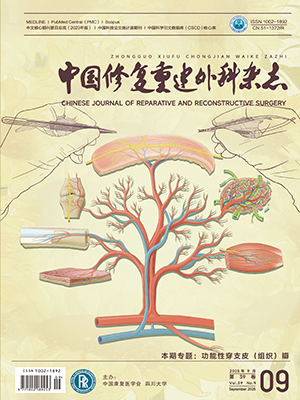| 1. |
Rammelt S, Zwipp H. Fractures of the calcaneus:current Treatment strategies. Acta Chir Orthop Traumatol Cech, 2014, 81(3):177-196.
|
| 2. |
Kinner B, Schieder S, Müiller F, et al. Calcaneocuboid joint involvementin calcaneal fractures. J Trauma, 2010, 68(5):1192-1199.
|
| 3. |
Yu GR, Pang QJ, Yu X, et al. Surgical management for avulsion fracture of the calcaneal tuberosity. Orthop Surg, 2013, 5(3):196-202.
|
| 4. |
Jiang N, Lin QR, Diao XC, et al. Surgical versus nonsurgical treatment of displaced intra-articular calcaneal fracture:a meta-analysis of current evidence base. Int Orthop, 2012, 36(8):1615-1622.
|
| 5. |
Gitajn IL, Toussaint RJ, Kwon JY. Assessing accuracy of sustentaculum screw placement during calcaneal fixation. Foot Ankle Int, 2013, 34(2):282-286.
|
| 6. |
Phisitkul P, Sullivan JP, Goetz JE, et al. Mximizing safety in screw placement for posterior facet fixation in calcaneus fractures:a cadaveric radio-anatomical study. Foot Ankle Int, 2013, 34(9):1279-1285.
|
| 7. |
LevyA, Berkowitz R, Franklin P, et al. Magnetic resonance imaging evaluation of calcaneal fat pads in patients with OS calcis fractures. Foot Ankle Int, 1992, 13(2):57-62.
|
| 8. |
Sanders R, Fortin P, DiPasquale T, et al. Operative treatment in 120 displaced intraarticular ealcaneal fractures. Results using a prognostic computed tomography scan classification. Clin Orthop Relat Res, 1993, (290):87-95.
|
| 9. |
陈雁西, 俞光荣. 动静脉泵在骨科临床应用中的现状与展望. 中华创伤杂志, 2005, 21(4):309-311.
|
| 10. |
校伯平, 李明, 王邦荣, 等. 跟骨骨折的临床解剖学观察及应用. 中国骨伤, 2010, 23(11):814-816.
|
| 11. |
Mahato NK. Morphology of sustentaculum tali:Biomechanical importance and correlation with angular dimensions of the talus. Foot (Edinb), 2011, 21(4):179-183.
|
| 12. |
Della Rocca GJ, Nork SE, Barei DP, et al. Fractures of the sustentaculum tali:injury characteristics and surgical technique for reduction. Foot Ankle Int, 2009, 30(11):1037-1041.
|
| 13. |
胡牧, 施忠民, 徐向阳, 等. 内侧入路切开复位内固定治疗跟骨单纯载距突骨折. 中华骨科杂志, 2013, 33(4):326-332.
|
| 14. |
施忠民, 邹剑, 顾文奇, 等. 经跗骨窦间隙与外侧"L"形切口治疗SandersⅡ型跟骨骨折的疗效比较. 中华骨科杂志, 2013, 33(4):298-303.
|
| 15. |
Pang QJ, Yu X, Guo ZH. The sustentaculum tali screw fixation for the treatment of Sanders type Ⅱ calcaneal fracture:A finite element analysis. Pak J Med Sci, 2014, 30(5):1099-1103.
|
| 16. |
张鹏, 黄勇, 张增方, 等. 跟骨载距突与其外侧壁关系的测量. 青岛大学医学院学报, 2007, 43(6):507-509.
|
| 17. |
Swanson SA, Clare MP, Sanders RW. Management of intra-articular fractures of the ealcaneus. Foot Ankle Clin, 2008, 13(4):659-678.
|
| 18. |
Brunner A, Müller J, Regazzoni P, et al. Open reduction and internal fixation of OTA type C2-C4 fractures of the caleaneus with a triple-plate technique. J Foot Ankle Surg, 2012, 51(3):299-307.
|




